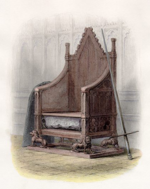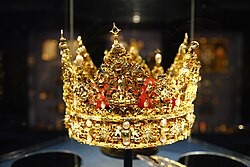Julian Throne and Crown Jewels of Urcea
This article is a work-in-progress because it is incomplete and pending further input from an author. Note: The contents of this article are not considered canonical and may be inaccurate. Please comment on this article's talk page to share your input, comments and questions. |
| Crown Jewels | |
|---|---|
| Overview | |
| Country | Urcea |
| Location | Julian Palace |
| Size | 142 objects |
| Oldest | Armlet of Conchobar I |
| Newest | Riordan VIII's Armills |
| Stones | 25,501 |
| Owner | Riordan VIII |
The Julian Throne and Crowns Jewels of Urcea are the Throne and ceremonial objects kept in the Julian Palace, which include the regalia and vestments worn by Apostolic King of Urcea at their coronations. It also includes much of the regalia of the Holy Levantine Empire, which are in possession of the Apostolic King of Urcea in his person as Emperor of the Levantines.
Symbols of nearly a millennia of Urcean Monarchy, the crown jewels are an accrued collection of more than 140 objects from a thousand years, dating back to the elevation of Urcean Kings in the Golden Bull of 1098 as well as some items dating to the Archduchy era. As a consequence of the Second Great War, the end of the Holy Levantine Empire, and the Treaty of Corcra, the Apostolic King of Urcea was permanently fused with the title of Emperor of the Levantines, bringing most of the crown regalia into the Urcean collection.
While the early elective Duchy of Urceopolis did not use regalia and regarded itself as an elective republic in the vein of early Great Levantia, the establishment of the hereditary Archduchy of Urceopolis precipitated the use of crown regalia in Urcean culture, following after the Gaelic tradition of Conchobar I and the early Levantine Empire. Early crowns were simple symbols of bronze or grass crowns, but the union of the Archduchy and the Duchy of Harren began to see the use of more prestigious headgear. The so-called Crown of St. Julius, the state crown of Urcea through the present, was created sometime in the 12th century following the Golden Bull of 1098 to serve as royal crown. The crown, an enduring symbol and unique symbol of Urcea, is prominently used in most of the symbols of the Government of Urcea.
Julian Throne

Like the regalia, the early Duchy of Urceopolis did not feature a distinct throne but rather something similar to a Consul's chair, a practice that continued with the inauguration of hereditary rule in the era of the Archduchy of Urceopolis. In the 10th century, when the Archduchy combined with the Duchy of Harren under one ruler, a throne of wood and ivory (imported from Hištanšahr) was produced. This throne included a hollowed seat where the Consular Stone was placed; the stone is thought to be from a seat belonging to ancient Great Levantine Consuls in the Levantine Forum sat in a place of judgment. This throne survived into the early royal era following the Golden Bull of 1098, but was destroyed, with the exception of the Consular Stone, during the early phases of the Saint's War in a fire at the Julian Palace. The current throne is thought to have been produced in the middle of the 12th century or the beginning of the 13th century around the Consular Stone, and some sources indicate this throne was originally intended to be temporary but was never replaced as a consequence of the conflict. Historians are divided on when it became known as the "Julian" throne, but most place the name originating during the Great Interregnum. Following the end of the Saint's War, House de Weluta continued to use the throne and, in 1652, King Brian I ordered the bottom half of the throne gilded with lions added, additions which remain through the current day.
An impressive wooden throne typical of Medieval design, the gilded lions symbolize the inherited legacy of Great Levantia claimed by the Apostolic King of Urcea. The Consular Stone built within the throne does likewise; both symbols have taken on additional symbolic value with the permanent fusion of the title Emperor of the Levantines with that of Apostolic King.
Crown of St. Julius
The Crown of Saint Julius is the primary Royal crown of Urcea. Despite its name, it was crafted in the 11th century for King Niall I, replacing an earlier circlet. The Crown of Saint Julius was initially similar to many other medieval crowns, featuring a relatively simple open-topped gold band with multiple fleur-de-lis and precious stones inlayed throughout the Crown. The original style of the crown is still used for its heraldic depictions. The crown remained largely the same until the late 16th century. During the reign of King Leo II, the crown was significantly altered to add many more stones, ivory figurines (such as an Imperial eagle), and both gold and ivory inlay. The many stones, added to reflect the increased prestige of the Julian dynasty and House de Weluta, were said to have doubled the weight of the crown. The changes to the Crown also inalterably changed its fundamental structure as many holes were added to it, both for stylistic reasons and also to support the new additions. Public interest in possibly restoring the medieval Crown led to a study conducted in 1946 which concluded that any such effort to remove Leonine innovations would likely destroy the Crown.

Since the 20th century, the Crown of St. Julius has become largely supplanted by the Imperial State Crown in heraldry. Increasingly, it has also become supplanted in physical use; although Riordan VIII is the first Apostolic King to use the Imperial State Crown nearly exclusively, his predecessors (including Aedanicus IX) began to use the State Crown in an increasing share of public events.
Iron Coronet of Canaery

The Iron Coronet of Canaery is both a reliquary and one of the oldest royal insignias of Christendom. It was made in the Early Middle Ages, consisting of a circlet of gold and jewels fitted around a central silver band, which tradition holds to be made of iron beaten out of a nail of the True Cross. The relic, which came into the possession of the Caens following the sack of Urceopolis in 434, was probably created into an earlier version of the crown in the beginning of the 6th century. The crown's history is unclear during the period of early Hištanšahr domination, but reappeared once Canaery was conquered by Conchobar the Great and incorporated into the new Levantine Empire. Used as the regalia for the Duchy of Canaery, the Coronet was probably significantly modified in the 10th century once Canaery was elevated to an Electorate. Upon Canaery's acquisition by the Urcean Crown in 1144, the Coronet became an important part of the regalia.
The Iron Coronet is used during the coronation ceremony of the Apostolic King of Urcea not only for the purposes of signifying his rule over Canaery, but additionally to confer a special religious connotation given the nail from the true cross. Traditionally, the King would wear the Iron Coronet - not the Crown of St. Julius - during the meetings of the Collegial Electorate. This was done as a sign of humility in order to appear before the College as "merely" Duke-Elector of Canaery. Though the Collegial Electorate ceased to function in 1935, the Iron Coronet still holds an important role in the Apostolic King of Urcea's connection to the title of Emperor of the Levantines. In the modern coronation ceremony, the King accepts "election" as Emperor while wearing the Coronet just prior to his coronation in the Imperial regalia. The Coronet remains a powerful symbol of Canaery and appears in its flag.
Imperial crown jewels
The Apostolic King of Urcea is in possession of the Imperial Crown and crown jewels of the Holy Levantine Empire, which are incorporated in various state uses. These items were acquired by House de Weluta upon election of King Niall VI as Emperor of the Levantines in 1920 and retained since. With the end of the Empire and its subsequent legal survival (known as the Empire-in-fact), the Apostolic Kings were granted the right to retain and use the Imperial items in perpetuity by the Treaty of Corcra.
Medieval Imperial crown
Imperial State Crown

The Imperial State Crown was the most prominent symbol of the Holy Levantine Empire and remains in common use by the Apostolic King of Urcea in various Imperial functions. It was created in 1602.
The crown is in a mitre style and has four golden panels, each of which depicting an important event in the history of the Empire: the coronation of Conchobar I as first Emperor of the Levantines in the 8th century; the coronation of Leo I following his reunification of the Empire in the 10th century; Emperor Carles II on campaign during the First Crusade in the 11th century, and; the final victory of Emperor Leo III during the Great Confessional War in the 16th century, which had occurred in living memory of the crown's creation. Accordingly, the four events are divided into the two halves of the mitre, with the wearer's left being the "coronation" side, depicting the Conine and Leonine coronations, and the wearer's right being the "victory" side, depicting two Emperors defending Catholic Christianity on the battlefield. Due to the appearance of Leo III, who was also the Apostolic King of Urcea from House de Weluta, the crown gained prominence over the Medieval Crown and other Imperial objects during the subsequent Imperial reigns of House de Weluta in the 18th and 20th centuries.
Notably, Riordan VIII is the first Apostolic King to use the Imperial State Crown in public appearances more than the Crown of St. Julius. The Imperial State Crown appears on most Government of Urcea-related seals and arms, and also appears on the House de Weluta arms which serve as Urcea's national symbol.
Crown jewels of the dependencies
Lariana
The Crown of Lariana was created in 1852 as a symbol of its separation from the other crownlands of Urcea, with the Crown representing the Kingdom as a standalone political and cultural entity.
New Harren
Other
The third major crown made for Urcea's overseas dependencies is that of the "Coronet of the Veltorines", intended for Riordan VIII's use as Prince of Cetsencalia. Created in 2019, the Coronet was used only twice in an official capacity before the Cetsencalian state was dissolved during the Final War of the Deluge. The Coronet remains within the Royal collection, though the Royal Household indicates it will no longer be used. There have been calls to melt the Coronet down or donate it to New Veltorina, any many politicans have questioned the utility of retaining the object within the Royal collection.
Royal and Prince's Missal
Within the Imperial Armory are two hand missals for use within the Catholic Church that are passed from father to son as is the custom within Urcean society: the Royal Missal and the Prince's Missal. The Royal Missal is to be held by the Apostolic King of Urcea for the duration of his reign, while upon ascension he is to pass the Prince's Missal to the Prince of Halfway.